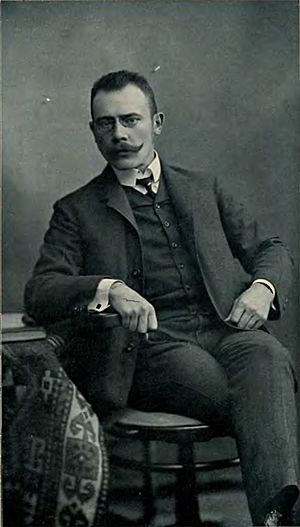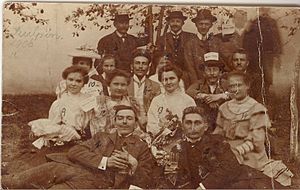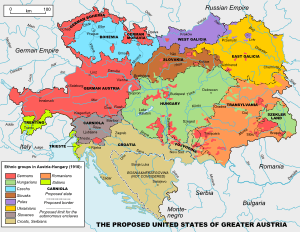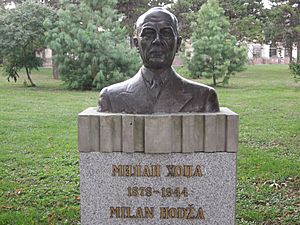Milan Hodža facts for kids
Quick facts for kids
Milan Hodža
|
|
|---|---|
 |
|
| Prime Minister of Czechoslovakia | |
| In office 5 November 1935 – 22 September 1938 |
|
| Preceded by | Jan Malypetr |
| Succeeded by | Jan Syrový |
| Acting President of Czechoslovakia | |
| In office 14 December 1935 – 18 December 1935 |
|
| Preceded by | Tomáš Garrigue Masaryk |
| Succeeded by | Edvard Beneš |
| Personal details | |
| Born | 1 February 1878 Szucsány, Hungary (now Sučany, Slovakia) |
| Died | 27 June 1944 (aged 66) Clearwater, Florida, U.S. |
| Political party | Slovak National Party Agrarian Party of Czechoslovakia |
Milan Hodža (born February 1, 1878 – died June 27, 1944) was an important Slovak politician and journalist. He served as the Prime Minister of Czechoslovakia from 1935 to 1938. He believed in bringing countries together and tried to create a group of democratic states in Central Europe.
Contents
Early Life and Education
Milan Hodža was born in a town called Sučany, which was then part of the Kingdom of Hungary. Today, Sučany is in Slovakia. His family name, Hodža, means "master" or "teacher" in Turkish. This name was given to his ancestors during the time of the Ottoman Empire.
He went to high schools, known as gymnasiums, in different cities. These included Banská Bystrica, Sopron, and Sibiu (now in Romania). He finished school in 1896. After that, he studied at universities in Budapest and Vienna.
In 1897, he began his career as a journalist in Budapest. He started and edited newspapers like Slovenský denník (from 1900 to 1901) and Slovenský týždenník (from 1903 to 1914). Later, during World War I, he worked as an editor for the Austrian press office in Vienna.
Early Political Career (Before 1918)
From 1905 to 1910, Milan Hodža was a representative in the parliament of the Kingdom of Hungary. He was a member of the Slovak National Party. This was the only Slovak political party in Austria-Hungary at the time.
He became a key leader and founder of the Slovak agrarianism movement. This movement focused on the interests of farmers and rural people. From 1906 to 1914, he was the vice-chairman of the Slovak National Party. He wanted to create his own political party to support his ideas, but World War I started before he could.
After 1910, Milan Hodža became a close advisor to Archduke Franz Ferdinand. The Archduke was next in line to the thrones of Austria and Hungary. Hodža suggested a detailed plan to turn the Kingdom of Hungary into a federation. This meant different regions, including a separate Slovak state, would have more self-rule. The Archduke hoped this would make the non-Magyar nations, who felt oppressed, feel more connected to the monarchy. However, Hungarian politicians strongly opposed this idea.
During World War I, Milan Hodža helped prepare for the creation of Czechoslovakia. In 1918, he was a member of the Slovak National Council. He also signed the Declaration of the Slovak Nation. This document officially joined the Slovaks with the new state of Czechoslovakia in 1918.
First Czechoslovak Republic (1918-1938)
After World War I, Milan Hodža became a leader of the Czechoslovak Agrarian Party in Slovakia. This gave him a lot of power over Czechoslovakia's policies. He influenced important changes like land reform, laws about farm taxes, and how the government was organized. He was also a key figure in the international movement for farmers' rights. He helped create the International Agrarian Bureau, which was a group for European agrarian parties.
From 1921, Milan Hodža was a professor of modern history at Comenius University in Bratislava. He also helped start many Slovak newspapers and magazines. He used these to share his political ideas. His writings were collected in a book series called Články, reči, štúdie 1-6 (Articles, Speeches, Studies).
Hodža served as a representative in the Czechoslovak parliament from 1918 to 1938. He held many important jobs:
- Representative in Hungary (1918-1919)
- State Secretary of the Ministry of Interior (1919)
- Minister for the Unification of Laws and Administration (1919-1920 and 1926-1929)
- Minister of Agriculture (1922-1926 and 1932-1935)
- Minister of Education (1926-1929)
- Minister of Foreign Affairs (1935–1936)
- Finally, he became the Prime Minister of Czechoslovakia from 1935 to 1938.
In the 1920s, Hodža believed that Czechs and Slovaks were one nation. This idea, called "Czechoslovakism," helped him get high positions in Prague. However, he often disagreed with Czech politicians. He wanted to make sure Slovakia's unique needs were met within Czechoslovakia, which was not common at the time. He even thought about creating a group of Slovak parties that would oppose the central government in Prague.
Later, his views changed. In 1938, he recognized that Slovaks were a separate nation with their own rights. In the summer of 1938, he included plans in his government program to change Czechoslovakia's central government structure. He wanted to give more power to regions through federal, self-governing ideas.
In 1936-1937, he tried to create a special economic zone. This zone would include Czechoslovakia, Austria, Romania, Hungary, and Yugoslavia. It was a step towards uniting the region economically. However, his government had to accept the Munich Agreement in 1938. This agreement led to parts of Czechoslovakia being given to Germany. Under pressure, Milan Hodža was forced to resign as Prime Minister.
Life in Exile
After the Munich Agreement in late 1938, Milan Hodža went to live in other countries. He lived in Switzerland, France (1939), Great Britain (1940), and then in the United States after 1941.
During World War II, he helped write a document about Slovakia's place within Czechoslovakia (in October 1939). In this document, he repeated his idea from 1938 for more self-rule for Slovakia. In November 1939, he created the Slovak National Council in Paris. This group was meant to be the main body for Slovak resistance against the occupation. He was its chairman.
In January 1940, the Slovak National Council joined with the Czech National Council to form the Czecho-Slovak National Council. This group, including its Czech members, was in competition with the Czechoslovak government-in-exile in London. This government was led by Edvard Beneš, who strongly believed in Czechoslovakism. The two groups often disagreed.
When the Germans took over Paris, British security forces arrested the members of the Czecho-Slovak National Council. This happened partly because of spies working for Beneš's group. Hodža eventually gave in and accepted a less important role in Beneš's State Council in November 1940. However, he did not take part in its activities.
In 1941, he moved to the United States. There, he worked on a plan for a Central European Federation. He published this idea in his book Federation in Central Europe (1942). American thinkers and government officials were interested in his plan. But it never happened because the Cold War began.
Milan Hodža received many high awards from Czechoslovakia, France, Italy, Romania, Yugoslavia, and Poland. On June 27, 2002, his remains were reburied in the National Cemetery in Martin, in his home country of Slovakia.
Family
Milan Hodža's son was Fedor Hodža, who also became a politician. Milan Hodža was also the nephew of the famous politician and poet Michal Miloslav Hodža.
See also
 In Spanish: Milan Hodža para niños
In Spanish: Milan Hodža para niños




